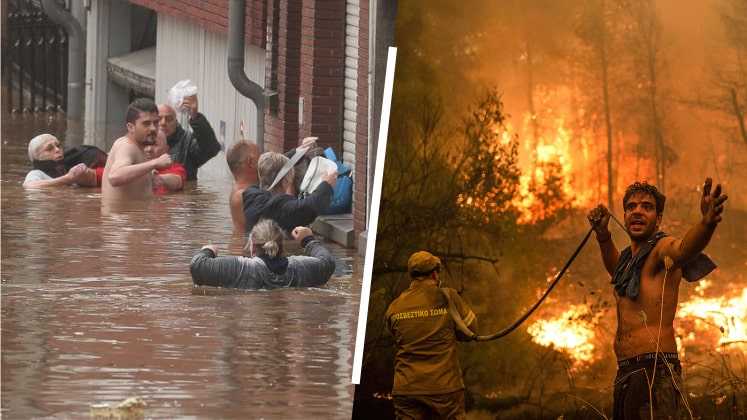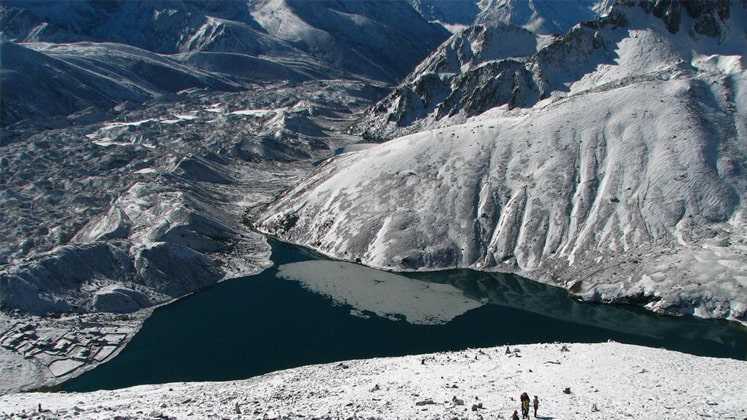
Climate change is the biggest crisis faced by humanity currently, and in some places, the crisis is even getting bigger than the pandemic menace. If unchecked, it could threaten not only the global economic development, but also the very existence of human life. It’s been going from bad to worse since last few years, but 2021 has been quite bad. There are heat waves, droughts, melting of glaciers and rising sea levels everywhere – all offspring of climate change. So it isn’t surprising to see wildfires, fuelled by extreme heat and drought, still ravaging many parts of Southern Europe, Turkey, Greece and Italy, and as this piece is getting written, the situation is turning to be quite bad. The deadly wildfires in Greece and Turkey have turned forests – and even homes – to ashes in last few months. While Turkish President Recep Tayyip Erdogan has called the fires the worst in his country’s history, Greek Prime Minister Kyriakos Mitsotakis has apologised amidst a backlash against his Government’s response to the country’s worst ecological disaster.
The situation is so bad in Greece that almost 100,000 hectares of forests and farmland have already been burnt in the fire that has also eaten away more than half the area of Greek Island of Evia. Close on the heels of Turkey and Greece getting devoured by the deadly fire, France and Portugal have also become the latest European countries to face the devastating wildfires that have torn across Europe amidst scorching, tinder dry conditions. Some 5,000 hectares (12,000 acres) of forest and scrubland in France have already been consumed by the fire that broke out on 16 August 2021, while in Portugal , firefighters are still struggling to control a fire in the tourist-friendly region of Algarve, with some firefighters, reportedly, receiving medical attention for burns and smoke inhalation.
It’s worse in Italy . The second week of August saw fires – stoked by hot winds – sweeping all through southern Italy, after a monitoring station in Sicily reported temperatures of 48.8℃ (119.84°F), which some scientists believe could be the highest ever in the history of Europe. Now such a high temperature was never heard of before in Europe! Notably, the wildfires have swept through 120,000 hectares of land in Italy so far this year, which is about three times the annual national average. That’s scary by any standards! Reportedly, much of the damage has been in national parks, which also includes the ancient UNESCO-protected beech forest in the Aspromonte national park in Calabria. Importantly, it will need at least 15 more years to recover.
Also Read : Wage Theft By 15 Top Brands
It was the same story in Western Canada recently. When the average temperature of the British Columbia village touched a record high of 49.6℃, breaking the previous highs of 47.9℃ in July 2021, the fast-spreading wildfires compelled authorities to evacuate an entire village in British Columbia.
It’s not just about Europe! Wildfires have been spreading across the United States as the region keeps getting hit by a heat wave that has risen the temperatures to record levels in many areas. In the American city of Las Vegas in Nevada, temperatures went up to scary 47.2℃ (117°F) on one of the days in August. All this comes just weeks after the dangerous heat wave that had hit North America, which killed many people instantly. Here one cannot overlook the devastation that the monstrous Dixie fire is causing in Northern California, where the fire has already burned 635,728 hectares.
The whole world seems to have got caught in this horrific web of climate demons that’s devouring villages and forests and thus killing human beings and animals. Back in 2020, nearly 3 billion animals were killed or displaced during Australia ’s devastating bushfires. A year later, their toll on species is becoming increasingly clear. Bushfires have wiped away over 20 per cent of Australia’s temperate forest cover , and this is according to a recent analysis in Nature Climate Change .
The experts now believe that climate change through greenhouse gas emissions is making the hot, arid conditions favourable to wildfires more likely to occur. It is also responsible for a number of other extreme events like flooding and storms.
As deadly floods swept through entire Germany and Belgium all through July 2021, the magnitude of the destruction left many scientists wondering how such devastation could happen in some of the world’s richest and technologically advanced nations. Starting 13 July, intense storms dropped as much as 15 centimetres of rain in just 24 hours, swelling streams that then swept away houses, bridges and cars and caused massive landslides. But then, it is still not surprising considering the way humans have been constantly abusing the nature since decades.
It’s been unusually raining this year in China and India too. Massive flooding struck the city of Zhengzhou and Henan Province in July 2021 . If media reports are anything to go by, then by 22 July 2021, 33 people had lost their lives with nearly 3 million people affected and 376,000 people relocated. Notably, Zhengzhou registered a record hourly precipitation 201.9 mm in just 1 hour (16:00 to 17:00), on one day, which is more than the typical July average. That says it all!
Several states of India are combating massive floods and landslides after heavy rains this year – distinctly showcasing how a huge country like India too is on the frontline of climate change. In the first 7 months of 2021, the country experienced two cyclones, a deadly glacier collapse in the Himalayas, sweltering heat wave and killer floods. In fact, in the Indian Himalayas, about 10,000 glaciers are receding at a rate of 30 to 60 metres (100 to 200 feet) per decade as global temperatures rise. Then there are cyclones that are becoming more frequent across coastal parts of India and also severe as sea temperatures continues rising. In May 2021, cyclone Tauktae claimed 155 lives in western India; it was the deadliest storm to hit the area in several decades.

Experts say that climate change is now making the Indian monsoon seasons more chaotic with substantial disruptions in weather patterns.
For several years, scientists, across the globe, have been warning of climate-change-induced flooding in Europe and Asia. What we saw in Germany, Belgium and China this year is just the beginning. Warmer air holds more moisture, which can translate into heavier rainfall and at this rate scientists believe that by 2100, flood damage across Europe could cost as much as € 48 billion per year, which will be a big jump from € 7.8 billion now. And if this continues, then European Commission’s Joint Research Centre says the number of people affected could more than double to reach somewhere around 350,000.
While all this threatens human survival, it could well hit every business – particularly those into apparel and fashion – in a big way.
An extended weather might redefine fashion
An extended weather could lead to an imbalanced economy and businesses might find themselves in the lurking shadows of danger – especially those in apparel, fashion or even footwear. The entire definition of how and what one needs to wear could undergo a change.

A summer in Europe generally runs from June to August (3 months), but with the fast-advancing global warming significantly increasing the likelihood of extreme weather, it could very well extend the season to 5 to 6 months or more in the years to come. It is roughly the same in the US also, where the summer starts in June and ends on 1st September. Now, that would require an in-depth business strategy on the part of an apparel retailer, a supplier and all involved in the supply chain to redefine and reshape what one is going to wear.
So, while casualwear comprising casual T-shirts, pyjamas or cool pair of sneakers could be in more demand, there could also be orders for maxis, midis, skirts and shorts. While it will be still too early to predict what product would be in demand in such a scenario, whatever it is, it will be a revolutionary change. The worrying part is that the day isn’t too far!
An extended weather is not just an extended summer. It could be an extended winter or a prolonged rainy season. The fashion industry may have already taken note of fast-changing climate across the globe and if the scenario remains same or gets worse, which it might in all likelihood, then the industry will have to go back to the drawing board and re-plan all their fashion business strategies.
And it may be extreme too…
While coming years could see unusually hot and humid weather in those parts of the globe, which never experienced such a climate before, there could be blood freezing cold in some other parts.
Natural fibres like linen and cotton, known mainly for their breathability and comfort, could be in demand in the textile industry of countries braving deadly heat waves, while there could be need of four-layered or five-layered clothing or specialised boots in regions battling frost bites and cold waves. Protective clothing or temperature regulators could just be ‘normal’ for the people to buy.
One easily noticeable effect of the climate change on apparel and fashion retail are sales of outerwear. Back in 2015, lack of ‘sweater weather’ in the US, owing to record warmth during October, November and December, resulted in excess inventory of sweaters, jackets and coats. In this regard, Benjamin Auzimour , US Managing Director for Saint James , said that the winter of 2015 was a sad example of how people just didn’t know what to wear anymore, which had a direct impact on one of Saint James ’ core businesses – wool knitting. That was 6 years back and it’s only got worst ever since.
Over the years, winter dresses show up in stores by the end of summer in many parts of the globe from the US and Europe to Indian subcontinent. However, if the weather patterns continue to result in hotter and longer summer seasons – extending to the fall – then shoppers, in all likelihood, would delay buying winter clothes till they feel the cold weather has actually arrived. And the reverse could also hold true!
Work from home has already impacted our way of dressing
The fashion business has already undergone a massive transformation in last one year. ‘Work from Home’ is no longer the ‘New Normal’. It is as normal as anything that is ought to be normal in this world. While COVID-19 compelled people to work from home all though 2020 and 2021, it has today actually become a choice for people in many parts of the globe. As the world now gets ready to battle the climate crisis and combat the extreme weather, work from home has gained more prominence. Also, let us not forget that work from home saves commuting time, energy and to some extent travelling cost as well.
People can today sit at the comfort of their air-conditioned or heater-supported rooms, and sip a hot beverage or a cold drink while working – thus braving all the extreme weather outside. Work from home has also defined what one is going to wear and what one is going to buy, and climate crisis is soon going to make work from home the ‘normal’. And, it’s all happening very fast!
With most of business meetings happening on a laptop/notebook inside temperature-regulated rooms of one’s home, sweatpants, leggings, shorts and loungewear are fast becoming inherent pieces of one’s professional wardrobes. According to Statista , the American sports apparel market was valued at US $ 105.1 billion in 2020 and is expected to reach US $ 113.4 billion in 2021. In the UK, sales of women’s athleisure bottoms were five times higher in December 2020 than they were in April 2020. Also, according to the market research company Allied Market Research , the global activewear industry is expected to reach around US $ 547 billion by 2024. Doesn’t that say everything?
If the climate menace, if we may call so, continues in similar vein, then the entire concept of fashion and apparel may have to be redefined completely. The pace at which the climate crisis is impacting the world today, the fashion industry needs to be prepared to navigate all unforeseen challenges.
However, many hope that all the disasters seen this summer, across the globe, will raise awareness amongst people, businesses and politicians alike, leading to bolder decisions to combat the fast-rising temperatures. In November 2021, leaders from 196 countries plan to meet in Glasgow for the UN Climate Change Conference (COP26) with the goal of agreeing on further action to combat climate change. The fashion world too will be eagerly awaiting the outcome of the meet.
Till then one can just hope that the companies continue with their sustainability initiatives and programmes, and make every single person in the world understand that ‘there is no planet B’.

Post a Comment